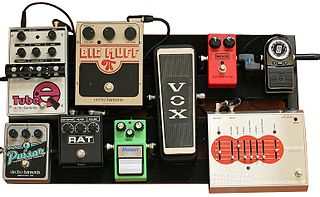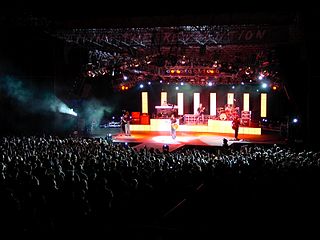Notable Products
F760X-RS 'Compex' Limiter
The F760X 'Compex' limiter was made up of three main parts; a compressor, limiter and a 'noise reducing' expander/gate. All of these parts could be used separately or together for well controlled sound limiting. This combination came about from client feedback. From the feedback ADR designed and built the first units, these were labelled as F760X-RS (RS meaning rack-mount stereo). Later modifications were made and another version was released with a better, ergonomically designed, front panel. This later model was labelled as the 'Compex'. [3] The 'Compex' limiter provided peak limiting with a multi-ratio, variable threshold compressor. Ratio settings ranged from 1:1 to 20:1 and there were controls for threshold and release time. The inclusion of an expander/gate provided attenuation of the gain during pauses in the audio signal to reduce noise caused by compression; the expander/gate could also be used for special 'punchy' effects, favoured on drum and percussive sounds. Noise gates were often criticised at the time for 'hunting' around the threshold point. The 'Compex' used clever hysteresis around the gate, this was important to stop unpredictable opening and closing of the gate; the open threshold was higher than the close threshold. [3]
The gain reduction controlled by the 'Compex' was monitored from two meters located to the right of the front panel. There were two light indicators; a red light lit when the signal level reached its peak, and when in expand mode a green light was lit. There were a set of lights for each channel, depending if the unit was the stereo or mono version.
There were some different models of the 'Compex' available; one of these included a smaller console module named the F760-N. This version was built without the expander/gate, it later had an expander/gate added and was then known as the F760X-N.
There is also a rare version called F760X-RS/T. One of the visible differences are the VU-meters, which got the brand "Audio & Design Recording LTD." and if one looks on the rear, there one can see the type.
The "T" stands for transformer, which are said to add harmonics to the sound. The "T" version was mainly used in broadcasting stations, mainly because of its SNR and headroom. ADR also built an F760 version for the Helios mixing consoles. [3]
Scamp Rack
Scamp stood for (Standardised Compatible Audio Modular Package). The system embodied the card-module concept within a standard racking frame. Although employing no specifically new techniques the design offered dramatic savings in packaging costs without degradation in performance standard. The rack was designed to be configured to different types of recording sessions using different types of modules. The rack could hold seventeen one inch modules all powered from the rack itself by use of an external power supply. A half-width rack with integrated power supply which could hold six modules was also available. [4]
Below is a list of the modules that were available.
- F300 Expander Gates
- S01 Compressor Limiter (FET-based)
- S02 Microphone Pre Amplifier
- S03 Sweep Equaliser
- S04 Parametric Equaliser
- S05 Dynamic Filter/Gate
- S06 Dynamic Filter/Gate
- S07 Octave Equaliser
- S08 Distribution Amplifier 2in / 8out
| - S12 Bantam patch-bay
- S14 LED Quad Meter
- S23 Pan effects module
- S24 Time Shape Module (Analog ADT, Flanger & Delay)
- S25 Dual De-esser
- S26 Mini Rack Power Supply
- S30 Expander
- S31 Compressor Limiter (VCA-based)
- S100 Dual gate
|

An effects unit or effects pedal is an electronic device that alters the sound of a musical instrument or other audio source through audio signal processing.

Dynamic range compression (DRC) or simply compression is an audio signal processing operation that reduces the volume of loud sounds or amplifies quiet sounds, thus reducing or compressing an audio signal's dynamic range. Compression is commonly used in sound recording and reproduction, broadcasting, live sound reinforcement and in some instrument amplifiers.

dbx is a family of noise reduction systems developed by the company of the same name. The most common implementations are dbx Type I and dbx Type II for analog tape recording and, less commonly, vinyl LPs. A separate implementation, known as dbx-TV, is part of the MTS system used to provide stereo sound to North American and certain other TV systems. The company, dbx, Inc., was also involved with Dynamic Noise Reduction (DNR) systems.

dbx, Inc. is an American producer of professional audio recording equipment owned by Harman International, a subsidiary of South Korea-based company Samsung Electronics. It was founded by David E. Blackmer in 1971.

A sound reinforcement system is the combination of microphones, signal processors, amplifiers, and loudspeakers in enclosures all controlled by a mixing console that makes live or pre-recorded sounds louder and may also distribute those sounds to a larger or more distant audience. In many situations, a sound reinforcement system is also used to enhance or alter the sound of the sources on the stage, typically by using electronic effects, such as reverb, as opposed to simply amplifying the sources unaltered.
Solid State Logic (SSL) is a manufacturer of high-end mixing consoles and recording studio hardware which is headquartered in Begbroke, Oxfordshire, England. Solid State Logic is part of the Audiotonix Group.

A noise gate or gate is an electronic device or software that is used to control the volume of an audio signal. Comparable to a compressor, which attenuates signals above a threshold, such as loud attacks from the start of musical notes, noise gates attenuate signals that register below the threshold. However, noise gates attenuate signals by a fixed amount, known as the range. In its simplest form, a noise gate allows a main signal to pass through only when it is above a set threshold: the gate is "open". If the signal falls below the threshold, no signal is allowed to pass : the gate is "closed". A noise gate is used when the level of the "signal" is above the level of the unwanted "noise". The threshold is set above the level of the "noise", and so when there is no main "signal", the gate is closed.

Scholz Research & Development, Inc. was the name of the company founded by musician and engineer Tom Scholz to design and manufacture music technology products.
Neve Electronics was a manufacturer of music recording and broadcast mixing consoles and hardware. It was founded in 1961 by Rupert Neve, the man credited with creating the modern mixing console.

Waldorf Music is a German synthesizer company. They are best known for the Microwave wavetable synthesizer and Blofeld virtual analogue synthesizer.
Aphex is a brand of audio signal processing equipment. Aphex Systems was founded in 1975 in Massachusetts. The company changed its name to Aphex in 2010.

Automated Processes Inc. is a manufacturer of high-end recording studio equipment, including stand-alone preamplifier designs, equalization units and mixing consoles. Their modular "lunchbox" design allows preamplifier, compressor and equalizer modules to be added to a recording studio design as budget allows. These modules include the 512c preamp, the 525 compressor, the 527 compressor, the 550a and 550b semi-parametric equalizers, and the 560 graphic equalizer.

BIAS was a privately held corporation based in Petaluma, California. It ceased all business operations as of June, 2012.
TC Electronic is a Danish audio equipment company that designs and imports guitar effects, bass amplification, computer audio interfaces, audio plug-in software, live sound equalisers, studio and post production equipment, studio effect processors, and broadcast loudness processors and meters. In August 2015, the company was purchased by Music Group, a holding company chaired by Uli Behringer.
In computer music and professional audio creation, a DirectX plugin is a software processing component that can be loaded as a plugin into host applications to allow real-time processing, audio effects, mixing audio or act as virtual synthesizers. DirectX plugins allow the replacement of traditional recording studio hardware and rack units used in professional studios with software-based counterparts that can be connected together in a modular way. This allows host manufacturers to focus on the conviviality and efficiency of their products while specialized manufacturers can focus on the digital signal processing aspect. For example, there are plugins for effects boxes, such as reverbs and delays, effects pedals, like guitar distortion, flange and chorus, and for mixing and mastering processors such as compressors, limiters, exciters, sub bass enhancers, stereo imagers and many more.

The 1176 Peak Limiter is a dynamic range compressor designed by Bill Putnam and introduced by UREI in 1967. Derived from the 175 and 176 tube compressors, it marked the transition from vacuum tubes to solid-state technology.

Ward-Beck Systemscommonly referred to as Ward-Beck or simply WBS, is a Canadian manufacturer of broadcast audio and video equipment. It was founded in a garage in April 1967 by Ron W. Ward and director of engineering, Rodger K. Beck.

Record is a music software program developed by Swedish software developers Propellerhead Software. Designed for recording, arrangement and mixing, it emulates a recording studio, with a mixing desk, a rack of virtual instruments and effects and an audio and MIDI sequencer. Record can be used either as a complete virtual recording studio in itself, or together with Propellerhead Software's Reason.
Calf Studio Gear, often referred to as Calf Plugins, is a set of open source LV2 plugins for the Linux platform. The suite intends to be a complete set of plugins for audio mixing, virtual instruments and mastering. As of version 0.90.0 there are 47 plugins in the suite.

The Fairchild 660 is a tube-based single-channel audio compressor invented by Rein Narma and manufactured by the Fairchild Recording Equipment Corporation beginning in 1959. The 660 was the first intelligent automatic volume control limiter. The Fairchild 670, introduced shortly after the 660, is a dual-channel version. The rarity of Fairchild compressors has made them highly desirable and very valuable, with a used 660 now selling for $20,000 or more and a 670 selling for $30-$40,000 or more. They are commonly referred to as the "holy grail" of outboard gear.














